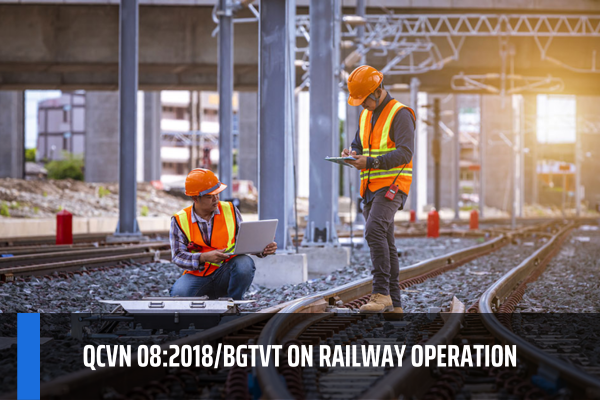What is the national technical regulation QCVN 08:2018/BGTVT on railway operation in Vietnam? What are the general regulations on railway vehicles?
- What is the national technical regulation QCVN 08:2018/BGTVT on railway operation in Vietnam?
- What are the general regulations for construction of railway projects in Vietnam?
- What are the general regulations on railway vehicles in Vietnam?
- Vietnam: Do railway vehicles have to have their registration number and name of the vehicle owner written on them?
What is the national technical regulation QCVN 08:2018/BGTVT on railway operation in Vietnam?
National technical regulation QCVN 08:2018/BGTVT is compiled by the Vietnam Railways, appraised by the Ministry of Science and Technology and issued by the Ministry of Transport according to Circular 32/2018/TT-BGTVT May 15, 2018, replacing QCVN 08:2018/BGTVT - National technical regulations on railway operation.
National technical regulation QCVN 08:2018/BGTVT on railway operations regulates the limits of technical characteristics and management requirements for railway works, railway vehicles, and organizations. Operate trains on national railways and specialized railways with rail connection to the currently operating national railway, track gauge 1000 mm, track gauge 1435 mm and double track (gauge 1000 mm and 1435 mm), with set speed below 120 km/h to ensure railway transport safety.
National technical regulation QCVN 08:2018/BGTVT applies to organizations and individuals with activities related to the national railway network and specialized railways with rail connections to the national railway.

What is the national technical regulation QCVN 08:2018/BGTVT on railway operation in Vietnam? What are the general regulations on railway vehicles? (Picture from internet)
What are the general regulations for construction of railway projects in Vietnam?
Based on point 2.1.1 subsection 2.1 Section 2 National Technical Regulation QCVN 08:2018/BGTVT, general regulations for construction of railway projects are as follows:
- To maintain regular railway transport operations and ensure safety, railway works must include:
+ Railway;
+ Railway station;
+ Depot;
+ Bridges, culverts, drainage works;
+ Railway tunnel;
+ Information system;
+ Signal system;
+ Fixed railway signaling system;
+ Power supply system and other auxiliary works and equipment of the railway.
- Railway works must be inspected regularly and periodically and must have records and technical records to monitor developments during use.
The content, inspection regime, reports of management levels and records and technical records of railway works must be carried out in accordance with the regulations of competent authorities.
- Any part of the construction and fixed or mobile equipment (except for equipment specified in section 2.1.1.4 National Technical Regulation QCVN 08:2018/BGTVT) must not violate the limit size. adjacent to the architecture specified in Appendix A and Appendix C issued together with National Technical Regulation QCVN 08:2018/BGTVT to ensure train operation safety and construction safety.
- Equipment that has a direct relationship with locomotives and rolling stock such as active road card delivery and receiving columns are considered exceptions, are allowed to violate the architectural contiguous limit and must comply with the regulations of the business enterprise. railway infrastructure.
What are the general regulations on railway vehicles in Vietnam?
Based on point 2.2.1, subsection 2.2, Section 2, National Technical Regulation QCVN 08:2018/BGTVT, general regulations on railway vehicles are as follows:
- Do not arbitrarily change the structure and features of major parts or install new equipment for gas railway vehicles participating in traffic. In case changes are necessary, they must ensure train safety and comply with the regulations of the Minister of Transport.
- The gauge limit of a locomotive or rolling stock is the contour of the largest cross-section of the locomotive or rolling stock placed vertically with the centerline of the road. Any part of a railway vehicle in a static, empty, loaded, new or old state that has reached the final limit standard placed on a flat, straight track must not exceed the gauge limit. The limits of locomotives and rolling stock are stated in drawings B.1 and B.2 of Appendix B issued with National Technical Regulation QCVN 08:2018/BGTVT.
Currently used railway vehicles that have some parts outside the locomotive and rolling stock limits that have been audited and approved for use will continue to be used.
Vietnam: Do railway vehicles have to have their registration number and name of the vehicle owner written on them?
Based on point 2.2.2, subsection 2.2, section 2, national technical regulation QCVN 08:2018/BGTVT stipulates as follows:
Regulations on vehicle registration, number, and information
2.2.2.1 On railway vehicles, in addition to having to write the registration number and inspection stamp according to regulations of the Minister of Transport, the vehicle number, name of the vehicle owner, place and date must also be written. manufacturing and periodic repair. Besides:
a) The locomotive must have a symbol showing the type, capacity, transmission type, model number, and weight. Particularly, rail cars must have seat numbers written on them;
b) The carriage must have its symbol and carriage number, self-weight, tonnage, seat type, bed type, length, width, height, capacity, time, oil filling place, brake check and other symbols. other private marks.
2.2.2.2 Passenger carriages and train captain's carriages must have hooks on both sides of the carriage and two end beams to place signals at the rear of the train. The hooks on both sides of the carriage must ensure that when installing standard lights, they do not exceed the size limit of the locomotive or carriage.
In case a freight train uses a signal device at the rear of the train instead of the train leader, the unit at the rear of the train replaces the train signal of the last car of the train.
Thus, based on the above regulations, on railway vehicles, in addition to the registration number and inspection stamp according to the regulations of the Minister of Transport, the vehicle number and name of the owner, place and date of manufacture and periodic repair must also be written.
LawNet